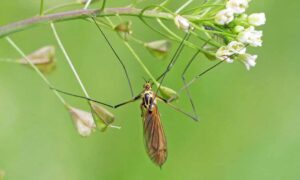
An old pasture with a few sheep, bordered on two sides by woodland, is usually unremarkable, but not today. A flock of starlings, 80-strong, erupts from spiky, olive-green rushes around the poorly drained margin, and for one angelic moment, their translucent primary wing feathers flash gold in the early morning sunlight. They circle, glide past us, land and are lost from view. Thirty seconds of magic in a mundane agricultural landscape.
We can see what brings them here; the evidence flutters in the undergrowth – an emergence of craneflies, mostly Tipula oleracea. The starlings are probing the ground for leatherjackets, craneflies’ subterranean larvae that feed on grass roots. Starlings’ long dagger beaks evolved to feed these to their young, not to squabble at a garden bird feeder and hack at suet balls.
Many adult craneflies emerging on this sunlit summer morning will survive to breed and some are already laying their eggs in the pasture. They dangle like trapeze artists from swaying grass stems, or settle on hogweed flower umbels, easy prey for birds, links in food chains. Swallows skimming the pasture will take their share, spiders’ webs will snare others.
Craneflies must be contenders for the title of least-loved insect, with their dangly, easily shed legs and tendency to enter houses through open windows on warm summer evenings. They are harmless, but a daddy longlegs fluttering around the bedroom is not conducive to a good night’s sleep.
In the rational light of day, their gangly, angular beauty is intriguing. Looking closely at this one on the hogweed inflorescence, I can see that its eyes are emerald green. And, as a member of the Dipteran order, it has exquisite halteres, those distinctive aerodynamic adaptations of flies where the hind wings are reduced to flexible club‑shaped hairs whose oscillations stabilise flight, counterbalancing every wing stroke – nature’s gyroscopes.
